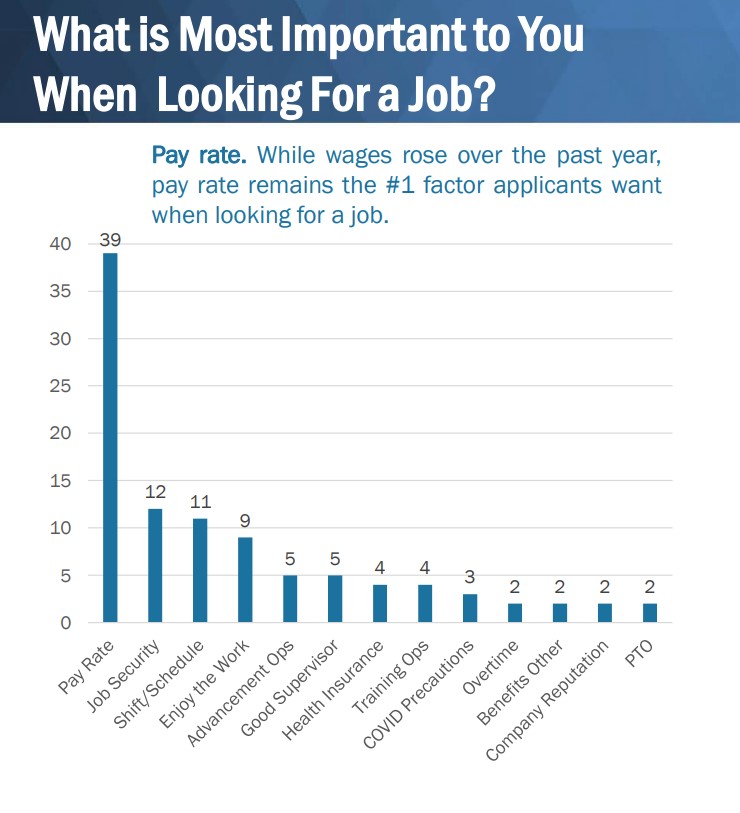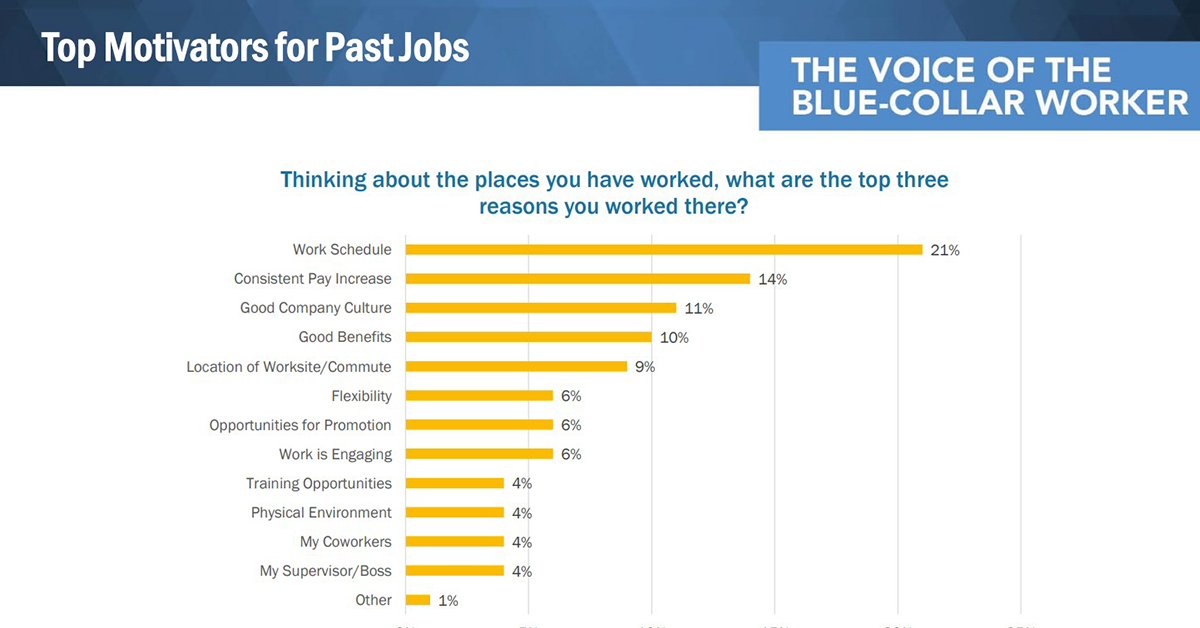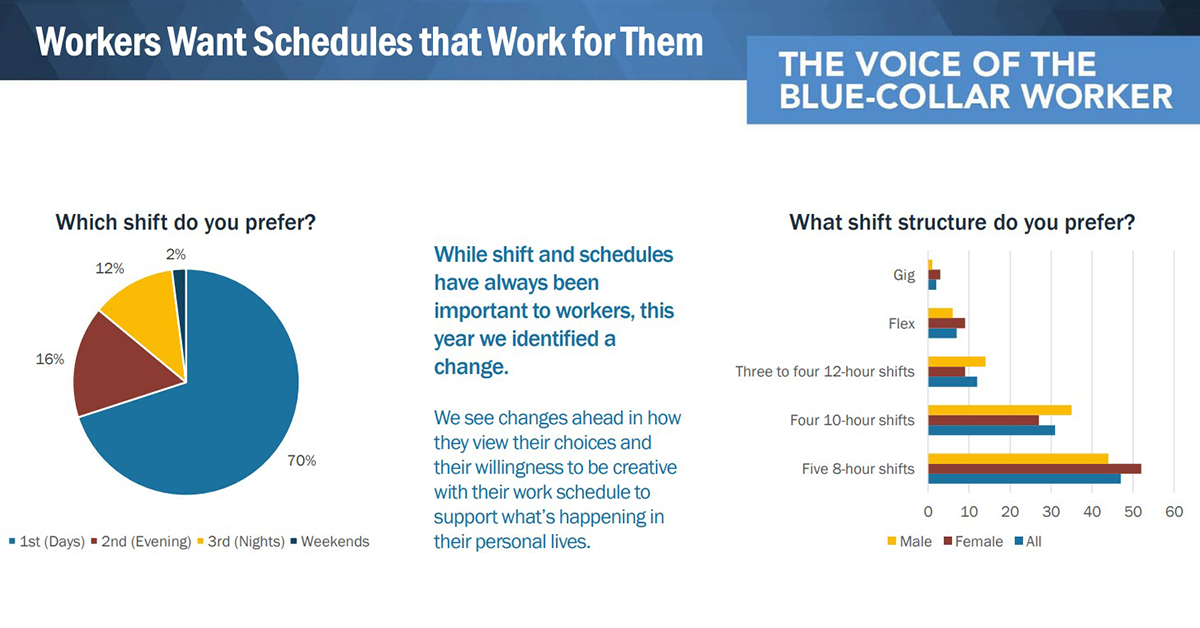Voice of the Blue-Collar Worker 2022
by Staff, on Jul 11, 2022 10:48:15 PM

Food Shippers of America (FSA) was recently at an association meeting with several other trade association that was hosted by its emergency response partner, the American Logistics Aid Network (ALAN) and gained access to the data on the largest U.S. survey of the hourly workforce – including transportation, logistics and food manufacturers.
The Voice of the Blue-Collar Worker is the nation’s largest survey of America’s hourly workers. Now in its 16th year, the survey continues to illuminate the unique factors that attract, motivate, and retain hourly employees. As threats to the supply chain persist, the importance of blue-collar work to our economic health and quality of life has been brought into sharp focus, and so have the challenges faced by working Americans each day. While the future is bright for the American industry, it’s more important than ever that we listen to and support our blue-collar workers so we can move forward together.
About the Survey
- Largest & longest running survey of the U.S. hourly, blue-collar workforce
- 16th edition - since 2007
- 19,491 wage earners participated
- Anonymous answers, multiple choice and free response
- Participants included hourly workers in transportation, logistics, and manufacturing
What Does the Current Workforce Look Like?
This year’s research underscores certain data points that provide food shippers, transportation and logistics companies with a unique perspective on the labor market:
- Labor force participation rate remains virtually unchanged at 62.3%
- 7 million more open jobs than people available to fill them (May 2022)
- 3 million people not working (May 2022 BLS)
- 46 million are 65+ YO; 53 million people are more than 16 years old

In addition, there’s a shifting of workers happening, which includes these highlights:
- Baby Boomers are retiring at a record pace.
- Millennials are the largest generation in the workforce.
- Change in the social contract between employer and employee in last 40 to 50 years.
- Millennials and Gen Z have a different perspective about work-life balance.
The study also revealed yearly job posting patterns have changed through a comprehensive assessment of production and manufacturing jobs in the U.S. labor market that were posted via Indeed. The study found that there was a 146% increase in job postings in May 2022 vs. January 2020 (prepandemic). In addition, there was a 79% increase in job postings since January 2021.
The study also found when assessing loading and stocking jobs, in the U.S. labor marketing there was a 133% increase in job postings in May 2022 vs. January 2020 (prepandemic), and a 51% increase in job postings since January 2021.
Key Findings of the Research
What is most important to those looking for a job. While wages rose over the past year, pay rate remains the primary factor applicants want when looking for a job. In fact, it’s leading factor, significantly stronger than the next factors of job security, schedule/shift, enjoyment of work, and COVID-19 precautions.

What are the top motivators for past jobs? When thinking about the places participants have worked in the past, they were asked to identify the top three reasons they worked there. Work schedule (21%), consistent pay increases (14%), and good company culture (11%) were the top three reasons. Additional reasons included good benefits (10%), location of worksite/commute (9%), flexibility (6%), opportunities for promotion (6%), and the work is engaging (6%).

Other questions asked were:
- Other than pay increases, what can companies do to earn your loyalty? Advancement opportunities rose to the number one position at 20%, with flexible schedule (15%) and specific items related to compensation and benefits joining the top five (provides 401K, health insurance contribution, and “understands I have obligations outside of the workplace.”)
- Which shift do you prefer? While shifts and schedule have always been important to workers, this year the study identified a change. Participants indicate changes ahead in how they view their choices and their willingness to be creative with their work schedule to support what’s happening in their personal lives.
- What shift structure do you prefer? In many cases, there were significant changes in shift structures preferred based upon gender, but most preferred five 8-hour shifts or four 10-hour shifts. A smaller percentage of respondents preferred three to four 12-hour shifts, flex or gig.

- How optimistic are you about your financial future? Workers are relatively optimistic about their future. Approximately 35% say they’re “Extremely Optimistic,” 29% say they’re “Very Optimistic,” and 27% say they’re “Somewhat Optimistic.” Another 5% say they’re “Not that Optimistic and another 4% say they’re “Not Optimistic.”
- How satisfied are you with your current job. There appears to be a significant number of people who have high job satisfaction. Approximately 20% say they are “Extremely Satisfied,” another 23% say they are “Very Satisfied” and another 34% say they’re “Somewhat Satisfied.” Another 10% say they’re “Not That Satisfied,” and another 13% say they’re “Not Satisfied At All.”
Recommendations for Food Manufacturers, Carriers and Providers
The study highlights six key recommendations for those in the food supply chain industry:
- Shift and schedule continue to be a priority for hourly workers. Add parttime/flexible shifts for current workers and to attract students, parents, 2nd jobbers.
- Competitive compensation – both wages and benefits – will continue to be vital factors, especially as rising inflation chips away at the dollar’s buying power.
- Be aware that employees have many job opportunities and align company views with the factual expectations of these workers.
- Demonstrate compassion and respect for the blue-collar workers and what they are experiencing personally, as well as professionally.
- Establish a strong, consistent onboarding experience for new hires that includes career advancement specifics.
- Review attendance policies and eliminate mandatory overtime whenever possible.
Want to dig deeper?
View this year’s Voice of the Blue-Collar Worker webinar or Download the report here. Or for more information, call EmployBridge at 888-381-7248.
Like this kind of content? Subscribe to our "Food For Thought" eNewsletter!
Now more than ever, professionals consume info on the go. Distributed twice monthly, our "Food For Thought" e-newsletter allows readers to stay informed about timely and relevant industry topics and FSA news whether they're in the office or on the road. Topics range from capacity, rates and supply chain disruption to multimodal transportation strategy, leveraging technology, and talent management and retention. Learn More



